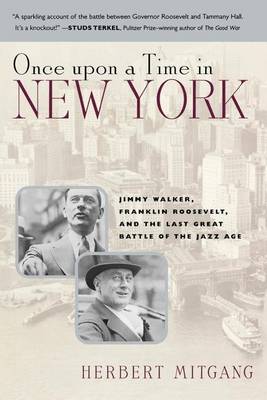The Jazz Age in New York -- a legendary time in America's liveliest town. Flappers and speakeasies. Gangsters and gun molls. Organized crime and its handmaiden: political corruption. Almost everybody and everything had a price. It was a great time to be a politician in power -- if you knew how to play the game. It was also a time of larger-than-life personalities. Two men, once friends, were locked in a political death-match that would affect New York and indeed the fate of the nation. Jimmy Walker was the nightclubbing Night Mayor of New York. The elegant Beau James had more mob ties than suits (and he had lots of them, too). Franklin Delano Roosevelt, a patrician from Hyde Park on the Hudson Highlands, was governor of New York. He was a crusader with a distinguished lineage, but he still had to prove that his talents could match his presidential ambitions. The bellringer between the mayor and the governor began with a very real murder. Arnold (Big Arnie) Rothstein, a world-class gambler who reputedly fixed the 1919 World Series, was found shot in the gut near one of his Broadway haunts. He survived for a few days but would not reveal the killer's identity. With his death came a crackdown against the underworld and its crooked officials. Judge Samuel Seabury, an incorruptible outsider, was picked to head what was -- and still is -- the largest investigation of municipal corruption in American history. In the witness box before Seabury sat an endless parade of officials, all of whom seemed to be unusually adept at saving money -- the press called them the tin box brigade for the tin boxes in which their private fortunes mysteriously blossomed. Each exposed officialdrew Seabury inexorably closer to City Hall and the popular rogue, Mayor Jimmy Walker. Taking advantage of the (rarely exercised) gubernatorial right to sit as judge for the investigation of major officials, Roosevelt brought things to a head when he personally prosecuted Walker in the summer of 1932, on the heels of the Democratic Convention. Roosevelt had much to lose. Behind Walker lurked Tammany Hall, the powerful Democratic political machine that ruled New York City. Prosecuting Walker was the final showdown in a war for control of the greatest city in the country's most populous state. Once Upon a Time in New York is a real-life fable, the story of two towering men in an irrepressible time. It is at once the story of Roosevelt's first great test; the turning point of machine control in New York; and the battle that marked the end of the Jazz Age way of political life. It is an unforgettable portrait of Roosevelt's courage, with a cast of gamblers and gun molls, murderers and mistresses. More outrageous than today's headlines and as lively as the era it describes, Once Upon a Time in New York reads like a nonfiction novel.
- ISBN10 1283890631
- ISBN13 9781283890632
- Publish Date 13 June 2014 (first published 5 January 2000)
- Publish Status Active
- Out of Print 4 November 2014
- Publish Country US
- Imprint Cooper Square Publishers
- Format eBook
- Pages 288
- Language English
